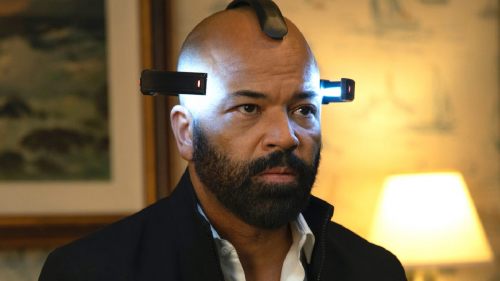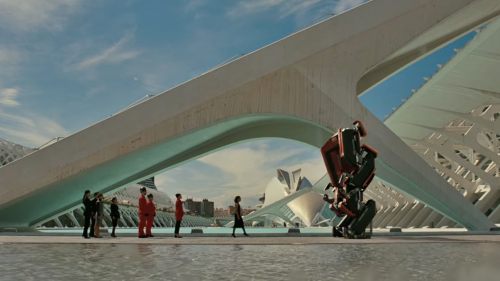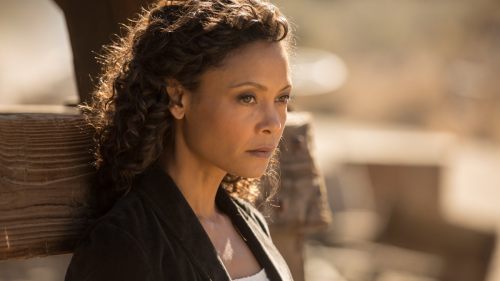WESTWORLD Review: 2.04 “The Riddle Of The Sphinx”
Funny thing about the way TV shows are aired: sometimes they give away their own secrets before the titles roll. “Previously-on” segments - designed to get the viewer up to speed with what’s to be relevant in the coming episode - can sometimes spoil the episode itself, as this week’s Westworld amply demonstrated. Through juxtaposition and callback, the pre-show montage all but reveals the answers to two of the show’s biggest recent mysteries: the identity of the woman from Park 6, and at least part of the park’s true purpose. A necessary evil, perhaps, but one that somewhat lessens the impact of in-episode revelations.
Luckily, “The Riddle of the Sphinx” is Westworld’s strongest episode yet, telling a surprisingly self-contained story with style, emotion, and intelligence, while developing its overall story and themes in interesting ways.
Though the episode is structured around flashbacks involving venture capitalist Jim Delos and fellow investor/gunslinger William, it’s Bernard who brings us to the episode’s revelations. Dragged to a cave by Clementine for reasons not entirely known, our malfunctioning robot protagonist runs into none other than fellow engineer Elsie. Back from season one seemingly out of nowhere, Elsie's reentry into the story is a welcome one, given that she's one of the show's few actually likable characters. Her presence at that particular cave feels far too convenient to be coincidence, but then again, as Bernard says, “Ford wrote a game and we're all in it.” How much happenstance and plot contrivance is Westworld going to attribute to its (at least currently) deceased Anthony Hopkins character?
The trajectory of the pair from there is led by some weird flashbacks and out-of-body experiences from Bernard. After receiving some much-needed cortical fluid, the nature of these flashbacks becomes clearer. Or more accurately, the way in which they're unclear becomes clearer. Bernard's memories play out to him out of order, with little sense of where they fall in the literal chronology of events - so much so that he even loses track of whether he's experiencing things live or just remembering them. It's interesting to see Westworld's penchant for timeline-jumping get built into a character: it feels like a pretty naked (and quietly hilarious) comment on the show's structure up until this point.
The flashbacks themselves, all dealing with the secret lab found inside the cave, are confusing and unsettling - to Bernard, most of all. Clearly, a ton of shit went down in here, at which it's eventually revealed Bernard was present for and even party to. But though there are still references to the park's guest-watching activities, the real purpose of the lab is something different entirely: attempting to build a robot-human hybrid, and to effectively bring a man back from the dead.
That man is Jim Delos: investor, Scotsman, and self-obsessed asshole, played to the hilt by the great character actor Peter Mullan. In a trio of flashbacks, we see Delos living in a hermetically sealed underground habitat, going about his daily routine before being visited and interviewed by William. Only, the second and third of these flashbacks don’t centre on Delos at all, but quasi-robotic clones (the nature of which isn’t quite specified). So long is this project underway, so many faulty clones do they chew through, that William goes from being played by Jimmi Simpson in the early flashbacks to Ed Harris in the final one. Each time Delos is “brought back to life,” new developments have occurred in the outside world, and new members of Delos’ family have died.
These Delos scenes are some of the most compelling material Westworld has yet produced, despite their disconnect with how the show started out. Mullan is astonishing here, both as a man (and his clones) discovering his mortality, and as an android whose cognitive functions can’t last beyond a few days. The storyline is also a pointed reference to the life-extension endeavours of real-life Silicon Valley billionaires, whose medical advances, when they occur, certainly won’t be shared with everyone. “People aren’t meant to live forever,” says William in the final control test, before leaving the Delos clone to lose his mind in isolation. I suspect the park’s “true purpose” is bigger than just this lab, but if this is where it started, it’s more sinisterly selfish than I’d imagined.
Delos’ story ends upon discovery by Bernard and Elsie, after clone #149 has been trapped, alone, in his gilded cage for long enough to trash the place - and himself. Co-creator and first-time director Lisa Joy utterly smashes this sequence, shooting it like a full-blown horror movie. With Delos cutting himself and talking of the Devil amid eerie red lighting, the scene is reminiscent of some of the darkest moments of Event Horizon or In the Mouth of Madness or some Hellraiser or other. It’s truly blood-curdling and surprisingly sad, with Mullan turning his guest role into a physical study of psychological horror. Westworld was transformed, temporarily, into a different, darker, and better show this week, and boy was I here for it.
Elsewhere in the park, William continues his journey through whatever “game” Ford set up before his apparent death. William’s constant talk of Ford’s plans for him are wearing thin with this viewer; something concrete had better come of all this soon. The story of William and Lawrence and Major Craddock is advanced little this week, other than building up Craddock’s considerable assholery before blowing him up, predictably, with his own torture instrument of choice. I suppose the flashback to his wife’s (and Delos’ daughter’s) suicide gives William a little extra motivation to continue, but frankly, in this episode, William in the present plays second fiddle to William in the past.
At least, until the arrival of William’s daughter, Emily. Last week, Emily escaped from a tiger but failed to escape from the Ghost Nation; this week, she corrects her failure. Given that Emily has spent enough time in the park to learn the Ghost Nation’s language, and that she clearly has more interest in them than a public who seems just as racist towards robot Native Americans as real ones, her escape via violence is a little disappointing. Emily’s got some stuff going on - she’s “not looking to get out of here,” in comparison to the other trapped guests - but it’s unclear what that is at this stage. In some ways, she’s very much her father’s daughter.
So what stuff does Emily have going on? Who is the other human/Cylon hybrid mentioned by Bernard? What the hell is this game Ford has supposedly cooked up? And why, oh why, has the park been watching and recording guest activity? More on this as the story (slowly) develops.



